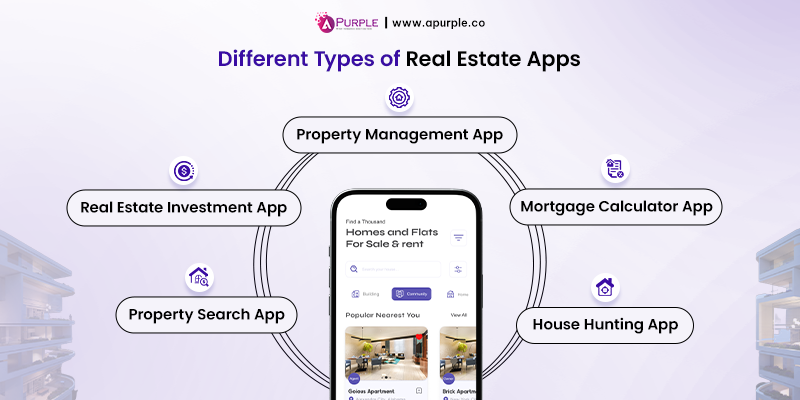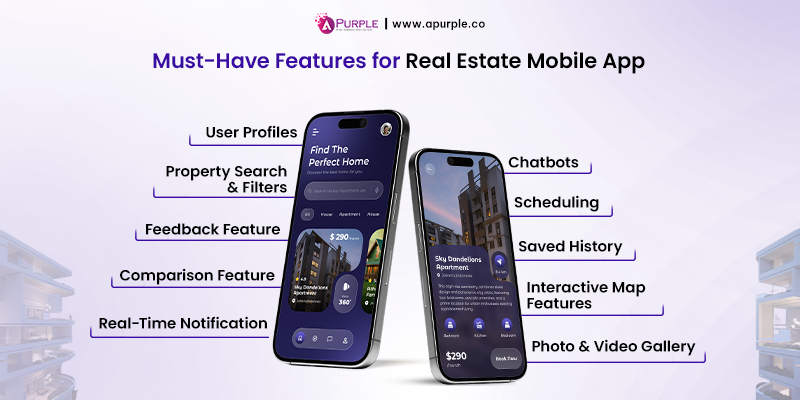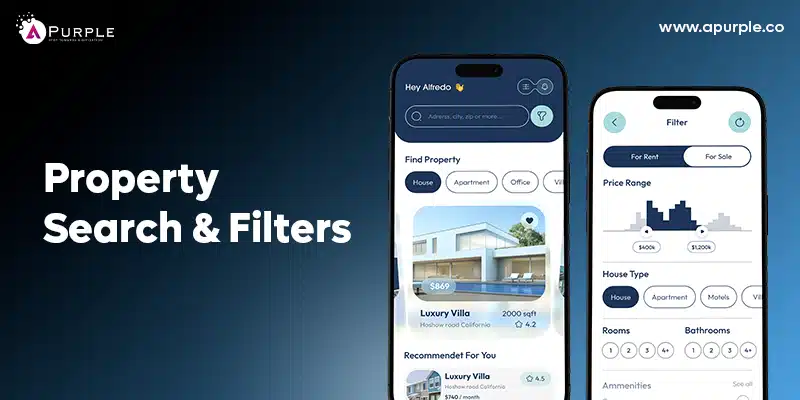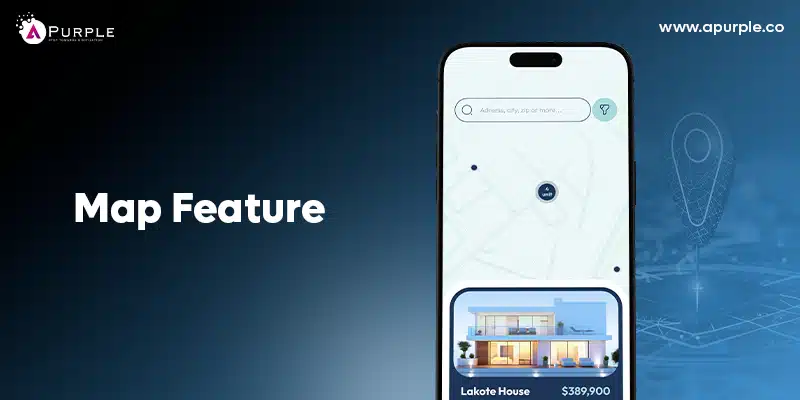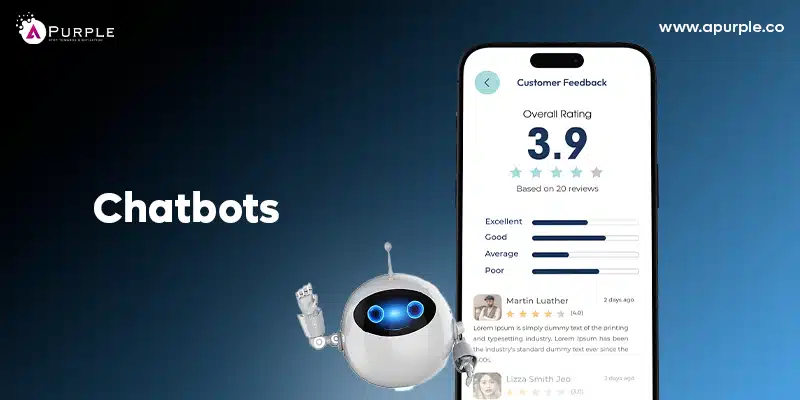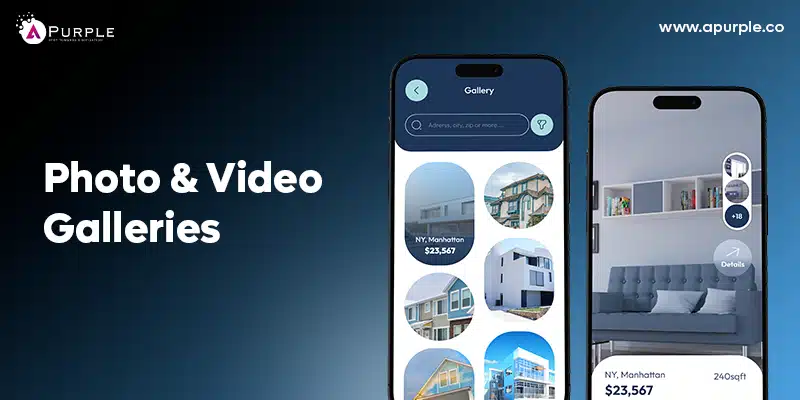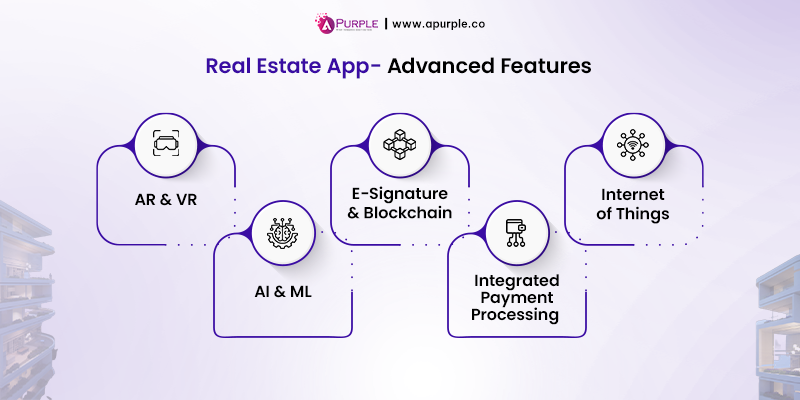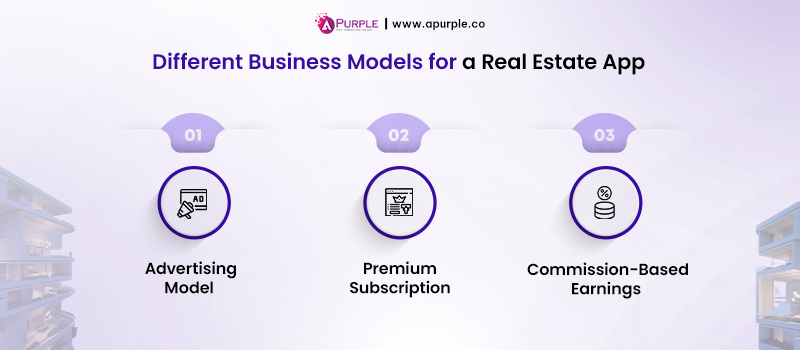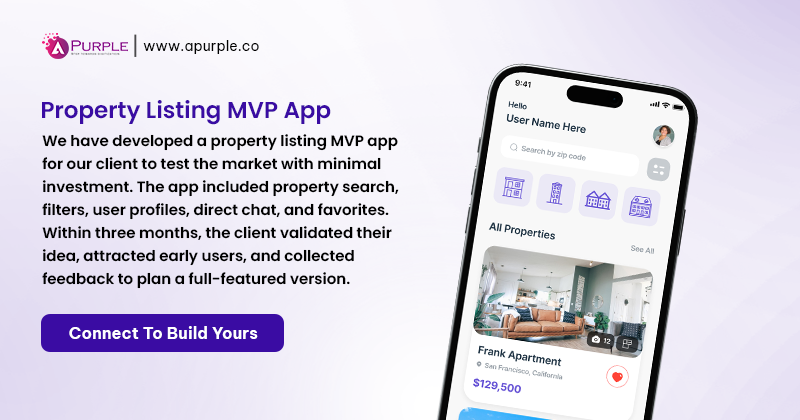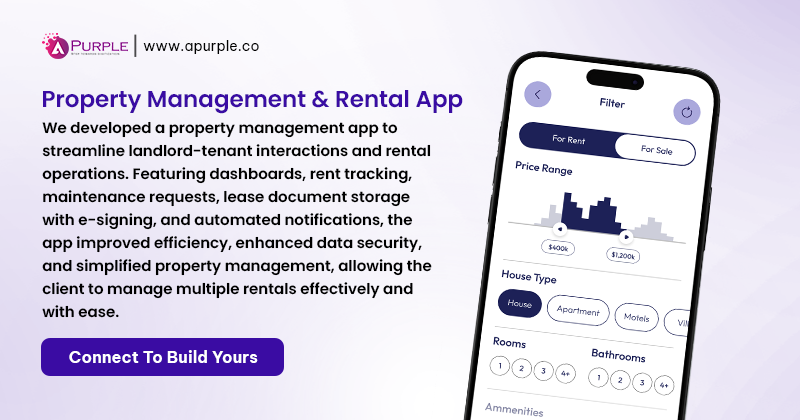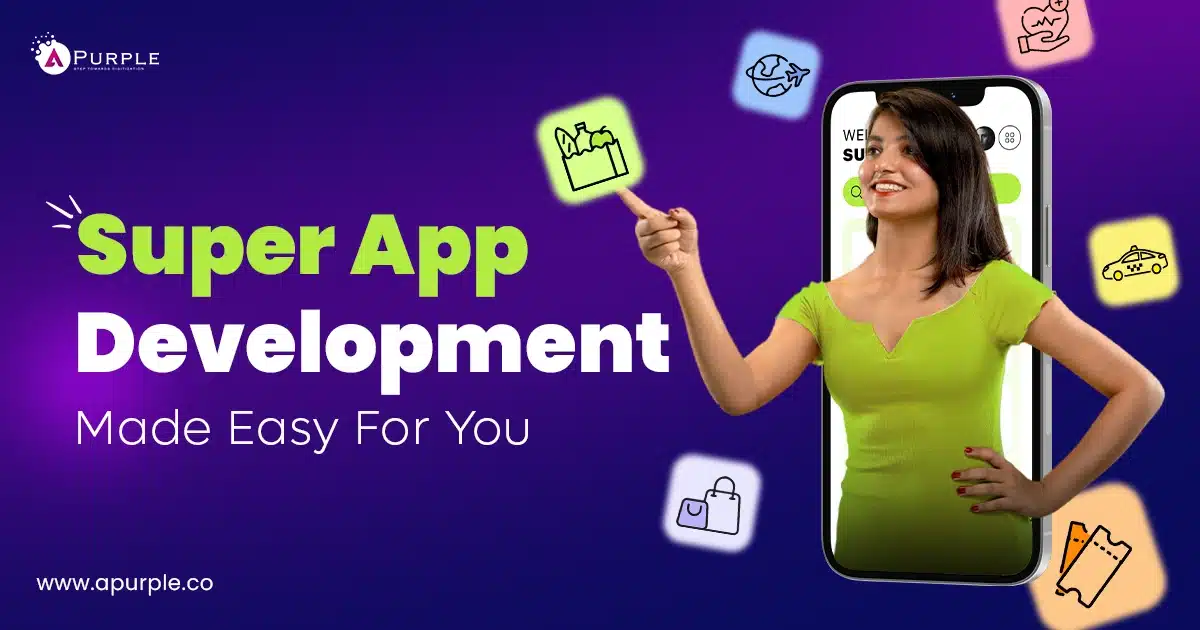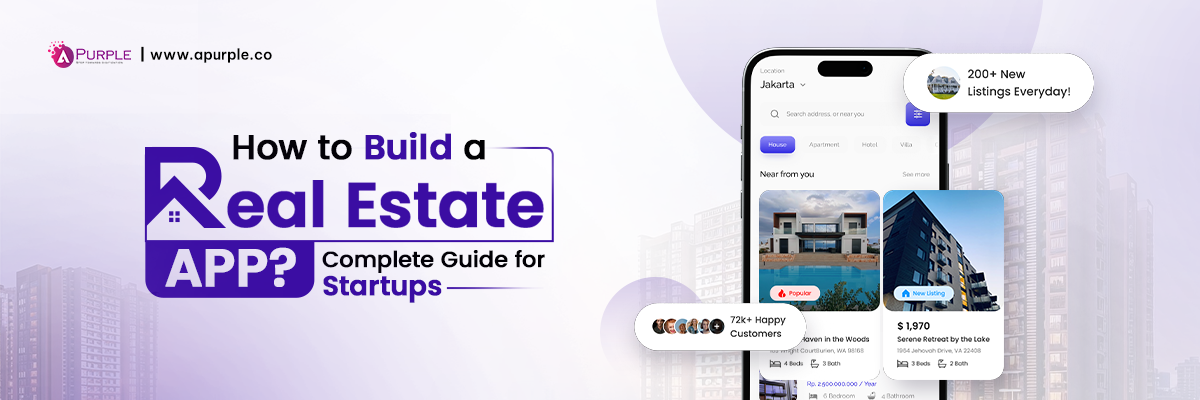
The real estate industry is changing faster than ever, and if you’re not evolving with it, you might get left behind. Real estate app development is vital for staying competitive. Whether you’re a startup real estate agency, an investor, or an independent agent, building a custom app can change the way you connect with clients, manage properties, and close deals.
Now, wondering how an app can help you outpace the competition? The key lies in simplifying operations, offering instant access to crucial information, and enhancing the customer experience.
With the market shifting toward digital solutions, ask yourself: Can you afford to miss out?
In this blog, we’ll explore how a strategic real estate app can empower your business to thrive in a competitive market.
What is Real Estate App Development?
Real estate development is the process of designing and developing a mobile or web application for the real estate industry. A real estate app connects buyers, sellers, renters, and real estate agents, enabling them to manage various properties, search for listings, and streamline transactions.
These applications enhance user experience with features such as virtual tours, AI-driven recommendations, communication tools, and property management solutions. These tools aim to increase efficiency, improve overall experience, and streamline the process of finding, buying, selling, or managing properties, making it faster and more convenient.
What are the Different Types of Real Estate Apps?
Mobile apps are changing the way we buy, sell, and manage properties. Today’s real estate apps not only help buyers find their dream homes but also assist investors, agents, and property managers in making smarter decisions.
1. Property Search Apps
Property search apps have become an important tool for users looking to browse homes. These apps simplify the process of finding properties that match users’ requirements, such as location, budget, and type.
If you are planning to build this type of application, you should integrate advanced filters, real-time notifications, interactive maps, and detailed property pages with photos, videos, and virtual tours.
2. Real Estate Investment Apps
Real estate investment apps have become an effective platform for people who are just looking to invest in real estate. These apps streamline the way to explore, analyze, and invest in real estate.
If you are planning to build this type of application, you need advanced analytical tools to analyze various factors that affect the return on investment (ROI), including location, infrastructure, nearby businesses, food courts, hypermarkets, and so on.
Additionally, these apps often feature fractional investing, which allows users to invest small amounts of money instead of requiring a substantial upfront capital.
3. Property Management Apps
When you manage several properties and customers, you need an app to maintain everything hassle-free. These real estate management apps serve as a bridge between the agents, landlords, and tenants, fostering transparency in the communication and rental process.
Also, the property management apps include vital data such as rent payments, maintenance requests, and tenant information. This helps bring transparency to the rental process and accessible communication between the tenants, agents, and landlord.
4. Mortgage Calculator Apps
The mortgage calculator app is an essential digital tool for agents, customers, and landlords. It helps estimate their monthly mortgage payments, interest rates, and home loan costs. This app allows users to put variables such as:
- Loan Amount
- Interest Rate
- Loan Term
- Down Payments
- Property Taxes and Insurance
5. House Hunting Apps
House-hunting applications are handy for homes and apartments to rent or purchase. Via hunting apps, you can provide filter listings such as location, budget, personal preferences, etc.
- Realtor.com
- Zillow
- Trulia
Read also: Why Choose aPurple For Your Airbnb Clone App Development?
What are the Benefits of Developing a Real Estate App?
Real estate mobile apps cater to three main audiences- home buyers, sellers, and real estate agents. Each group seeks to gain specific benefits within the real estate industry, including features like online booking, property filters, property management tools, and more. Below, we have outlined the benefits:
| Users | Buyers | Sellers | Real Estate Agents |
|---|---|---|---|
| Access to property listings | Easy property search | Wider reach & visibility | Centralized platform |
| Personalized suggestions | Virtual tours & AR views | Smart listing management | Lead management & CRM integration |
| Easy comparison of prices, locations, and others | Real-time updates | Real-time insights | Enhanced credibility |
| Seamless browsing & search experience | Direct communication | Faster deals | Time efficiency |
| Instant notifications | Secure document management | Cost-effective marketing | Data-driven insights |
What are the Steps Involved in Real Estate App Development?
Developing a real estate mobile app includes structured and strategic planning. In this section, we will explain the steps involved in the real estate mobile app development process.
1. Research & Planning
Before starting the development process for your real estate app, it is important to find the answers to the following questions:
- Who is your target audience?
- Who are your key competitors in the real estate market?
- What are the existing gaps or pain points in the real estate industry that your app can solve?
- What type of real estate application do you want to develop?
- What are the current user expectations from a real estate app?
Finding answers to these questions at an early stage will help you in validating your mobile app idea, identifying market opportunities, and planning a development strategy that aligns with user needs and industry trends.
2. Design the UI/UX
The next step in the real estate app development is to select the UI/UX design. The UI/UX design plays an important role in engaging and retaining users. While designing, make sure your app design must:
- Has an attractive and visually appealing interface.
- Aligns with a modern color palette, fonts, and visual elements that reflect your brand identity and build trust.
- The platform offers straightforward navigation that allows users to easily search for, filter, and explore properties.
- Focus on user-friendliness, with interactive elements and layouts.
- Balances visuals and performance by optimizing images and videos to ensure the app runs smoothly without delays.
In addition to the above, there are many other factors to consider when designing the UI/UX of your real estate app. Creating a user-friendly and visually appealing interface will enhance the overall app experience, keep the user engaged, and build confidence in your platform.
3. Choose the Right Tech Stack
The selection of the tech stack plays an important role in the real estate app development process. Choosing the right tech stack ensures that your app remains secure, scalable, and smooth. While selecting your tech stack, there are a few things to keep in mind:
- Must support large property databases to manage listings, images, and user data efficiently.
- Enables smooth integration with map and geolocation services for property searches and navigation.
- Can handle real-time updates to keep property information, availability, and pricing.
- Ensures scalability and flexibility to accommodate future features.
- Provides strong security measures to protect sensitive user and transaction data.
Below, we have mentioned the list of tech stacks for the real estate development:
| Programming Languages |
|
| Frontend |
|
| Backend |
|
| Database |
|
| Cloud Services |
|
| Map & Geolocation |
|
| Payment Gateway |
|
Expert Insights: Partnering with an experienced company for their mobile app development services gives you a strategic advantage. Experts help you choose the right tech stack, ensure seamless integrations, and build a secure, high-performing app that’s scalable and ready for market success.
4. MVP Development
For startups, developing a minimum viable product (MVP) is an excellent way to validate their mobile app idea before investing in full-scale development. An MVP allows you to test your concept, check its functionality, and gather valuable feedback from real users. In addition to these advantages, creating an MVP helps minimize risk, save costs, and ensure that your app effectively meets user needs.
Expert Insights: Partnering with an experienced MVP development company helps startups to validate ideas quickly. An expert team focuses on essential features, creates scalable prototypes, and delivers actionable insights, helping reduce risk and speed up your app’s launch.
5. Full-Scale Development
After validating your real estate app idea and core features, the next step is to do the full-scale development. This phase focuses on building an app with advanced features and functionalities for your users.
While developing your app, make sure to:
- Integrate advanced features such as AI-based property recommendations, AR/VR property tours, mortgage calculators, and other features.
- Ensure seamless integrations with payment gateways, CRM tools, analytics platforms, and third-party APIs.
- Update UI/UX design based on the feedback from your MVP users to make the app visually appealing.
- Optimize for multiple platforms (iOS, Android, web) to maximize reach and engagement.
6. Testing & Quality Assurance
The next step in the real estate app development is testing and quality assurance. Following these steps ensures that your app works smoothly, is secure, and meets user expectations. During this process, make sure to:
- Conduct functional and usability testing.
- Test performance and load handling.
- Check security vulnerabilities.
Proper testing ensures a bug-free, secure, and smooth app experience, building trust with users and laying the foundation for long-term success.
7. Deployment & Launch
Once testing is complete, your app is ready for deployment and launch. This step involves making your app available to users on app stores or the Play Store and ensuring everything runs smoothly. During deployment, make sure to:
- Publish on Google Play Store and Apple App Store.
- Ensure compliance with store guidelines and local data privacy laws.
- Set up backend servers and databases for seamless live operations.
- Plan a phased rollout or beta launch if needed to manage traffic and feedback efficiently.
8. Marketing & Promotion
Now it’s time to market your app, effective marketing and promotion will attract, engage, and retain users. For real estate apps, visibility and trust are the key to growth. During the marketing and promotion, keep in mind to:
- Optimize for app stores with relevant keywords, descriptions, and visuals.
- Use social media platforms to promote your application.
- Run paid campaigns targeting your audiences.
- Monitor analytics to measure campaign effectiveness and refine strategies.
What are the Must-Have Features for Real Estate Mobile App Development?
Now that you understand the real estate app development process, it’s time to learn about the essential features your app should have to ensure it is user-friendly. Below, we’ve outlined some of the core features:
1. User Profiles
Defining user profiles in your real estate app is important. This feature offers a personalized experience for buyers, sellers, and agents alike. With individual profiles, users can save their preferences, track property searches, and receive tailored recommendations. For sellers and agents, a dedicated profile acts as a professional storefront, showcasing their expertise, past transactions, and client testimonials.
2. Property Search & Filters
The search and filter option is another important feature for the real estate application because it lists properties, locations, or prices. In the search bar, users can enter specific keywords they’re looking for, such as flats, rental homes, workspace, etc. And, if you want to add something advanced to it, then you can add filters in it, which contain multiple filters, including-
-
Locations-
Specify cities, neighborhoods, or even specific streets.
-
Price Range-
In this, users can set minimum prices to maximum price limits.
-
Property Type-
Users can choose property types like single-family homes, condos, apartments, or commercial properties.
-
Amenities-
Users can choose amenities such as swimming pools, garages, or pet-friendly.
3. Interactive Map Features
interactive map feature indicates the ease of browsing directions in your app only, and not going to other apps to get directions to the properties. It provides visual and geographical presentations that enhance the user experience by showing directions and nearby stores, restaurants, hotels, etc.
To increase attraction, you can also integrate the 3D tour of the street and nearby attractions for the users.
4. Chatbots
Through live chatbots, users or agents can take real-time consultations via your real estate application. It is a creative way not to lose your users when they come. You can also add an audio or video call facility for users to interact with respective agents or vice versa.
5. Comparison Feature
Selecting a property for purchase or rent is a challenging task for anyone. Also, sometimes it feels difficult in both ways: when there are no options available and too many reasonable options to choose from. While searching for properties on the internet, users tend to compare options by reviewing them on different sites.
So, by integrating comparison features, you can make life easier. In this, you can integrate features such as:
- Compare Multiple Properties
- Key Information at a Glance
- Visual Comparison
- Save Comparison List
- Easy-to-Use Compare Button
6. Save & Revisit Your Choices
The Saved Favorites & History feature makes it easy for users to keep track of the properties they like. They can save listings, revisit past searches, and compare options anytime without starting over.
For sellers and agents, this feature gives useful insights into what users are interested in. It helps them understand buyer preferences and share more relevant property suggestions, improving the overall experience for everyone.
7. Scheduling
The scheduling feature allows users (both property seekers and agents) to manage and organize property-related appointments. It includes the facility of–
-
Property Viewing Appointments
-
Appointment Reminders and Alerts
Users can book appointments to visit the property according to the time slots. It helps both parties to work without needing back-and-forth communications.
Integrate such technology, automatically sending reminders or alerts to users (property seekers and agents) of upcoming appointments to help them stay organized. The reminders or alerts can be customized, such as the timing alerts (e.g., one day or an hour prior). The examples of the tools are –
- Google Calendar API
- FullCalendar
- ScheduleOnce
8. Real-Time Notification
Adding real-time notification features to your real estate app ensures users stay connected with timely updates on new listings, offers, and messages. This simple yet powerful feature improves user engagement and helps your app deliver a better, faster experience.
9. Feedback Feature
Providing proofs or testimonials is the new way to retain your users. It builds trust between your targeted audience and potential buyers. It helps your acquired audience get insights into others’ experiences with your real estate app development solutions.
10. Photo & Video Gallery
Photos and video galleries are essential features of real estate app development. These galleries show high-quality images, allowing users to explore everything about the property. Alongside photos, you can offer video tours, providing exploration of an immersive exploration of the property.
What are the Advanced Features that Should be in a Real Estate App?
Nowadays, users seek more than just basic functionalities in mobile app, they crave innovative and advanced features that elevate their experience. Integrating basic features like user registration to feedback is OKAY, but using advanced features can set you apart from your competitors and the market.
Below, we have mentioned the advanced features that you should include in your real estate app to attract users and make your place in the market.
1. Augmented Reality (AR) and Virtual Reality (VR)
By providing immersive virtual property tours or 3D visualization of properties, augmented reality and virtual reality can enhance the flow of real estate applications. Integrating augmented and virtual reality will make customizing furniture, decorations, or wall colors for your desired property easy.
Having such a feature can elevate the thinking of buyers or renters to visualize what the property should look like. And it can be witnessed anytime and anywhere.
2. Artificial Intelligence (AI) and Machine Learning
Artificial intelligence is known for its potential to learn from experiences, which helps in real estate in a way that feeds every information mentioned by searchers and then shows them AI-driven property recommendations. The biggest inspiration will surely be Zillow for you to integrate AI in your real estate app development because it is the first platform that uses AI in its real estate app to predict property value based on its price history, location, market changes, and more.
And guess what, to know the user behavior pattern, AI cannot do it alone. To make this possible, AI can be combined with machine learning to study user preferences and collect data to provide accurate recommendations and suggestions.
3. E-Signature and Blockchain
Handling paperwork in real estate can be time-consuming and complex. By integrating e-signature functionality, you can simplify the entire process for your users, allowing them to review, sign, and complete documents remotely without the hassle of in-person meetings.
To enhance security, incorporating blockchain technology ensures all sensitive data, from personal details to payment information, is stored and shared safely. It also provides transparency and prevents document tampering, giving users confidence and trust in your platform.
4. Integrated Payment Processing
Adding a payment processing feature to your real estate app will help users to make secure transactions directly within the app, whether it’s rent deposits, utility bills, or other payments. This will enhance convenience for users and also increase trust and engagement with your platform.
To integrate this feature seamlessly and safely, it’s important to partner with an experienced real estate app development company that can ensure smooth and reliable payment operations.
5. Internet of Things (IoT)
Integrating IoT in your real estate app allows physical devices like thermostats, security cameras, and door locks to communicate in real-time, providing smart control and monitoring.
The key benefits of integrating IoT in your real estate app are:
- Smart Property Management: Users can control and monitor properties remotely, from adjusting thermostats to managing security systems.
- Real-Time Property Insights: Your app can provide live data on energy use, temperature, or maintenance issues, helping users make informed decisions.
- Enhanced Security: IoT-powered systems enable remote access control, motion alerts, and live camera monitoring, ensuring safety and peace of mind for owners and tenants.
What is the Real Estate App Development Cost?
As a startup founder, you might be wondering, How much does it actually cost to develop a real estate app?
Well, the answer to this depends on several factors, including the type of app you want to build, whether you’re going for an MVP, a basic app with minimum features, or an AI-assisted app.
Below, we’ve broken down the estimated cost range for building a real estate app.
| App Type | Development Cost |
|---|---|
| MVP | USD 11,000 to USD 15,000+ |
| Simple App | USD 12,000 to USD 16,000+ |
| Moderated App | USD 15,000 t0 USD 20,000+ |
| Complex App | USD 25,000 to USD 30,000+ |
| AI-Assisted App | USD 30,000 to USD 40,000+ |
Note: The real estate app development cost may vary depending on features, tech stack, and other requirements.
Apart from the type of app, several other factors also affect the real estate app development cost:
- App design complexity
- Features and functionality
- Tech stack & platform
- Development team location
- Integrations and APIs
- Advanced technologies
- Compliance and security
What are the Different Business Models for a Real Estate App?
After exploring the real estate app development process, key features, estimated costs, and other details of developing an app, the next step is to choose the right business model. The model you select will determine how your app generates revenue and sustains long-term growth.
Below, we have listed some real estate business models that you could choose for your business.
1. Advertising Model
You can put advertisements on third-party brands or platforms. However, remember that these in-app advertisements do not compromise your user experience with real estate mobile applications. To earn from advertising is simple math: you can charge property management firms, real estate agents, and related businesses for ad space.
2. Premium Subscriptions
Premium subscriptions are for those who get advanced real estate mobile app features. In your app’s free version, you can provide features such as property listings, search functionality, map integration, a property detail page, a user account, a contact agent/owner, and notification/alerts.
However, in the premium real estate version, you can add virtual and 3D tours, personalized property recommendations, and an ad-free experience. This approach is essential in mobile app development for real estate, as it helps cater to the diverse needs of users and enhances their overall experience.
3. Commission-Based Earnings
Integrating a payment gateway will help you earn commission on every transaction between buyers and sellers. The number of successful users will translate into your success in terms of revenue.
Real Estate App Development- Case Studies
At aPurple, we understand our clients’ requirements and develop solutions that are tailored to their business needs.
Have a look at some of our recent real estate apps that we developed for our clients from Saudi Arabia, Kenya, and Kuwait. These solutions have significantly boosted efficiency and customer satisfaction.
What Challenges Occur in Real Estate App Development?
Below, we have mentioned the challenges with the solutions that will occur in the real estate app development:
1. Complex Property Listings
Real estate apps need to handle thousands of listings with images, videos, descriptions, and real-time updates. Managing this data can be challenging.
2. User Engagement & Retention
This is another challenge you can face. Users expect seamless search, quick responses, and engaging features like virtual tours. Poor UI/UX design can lead to high user turnover.
3. Real-Time Communication
Buyers, sellers, and agents need instant updates on property availability, offers, or inquiries.
4. Security Payments & Transactions
Another challenge that you can face is handling payments, deposits, or service fees involves sensitive financial data and regulatory compliance.
5. App Scalability & Performance
High traffic, large files, and multiple users can slow down your real estate application.
Wrapping Up!
Real estate app development is not just about following trends but has become necessary in today’s tech-driven environment. The real estate industry is rapidly growing, with apps becoming more user-friendly and feature-rich, enhancing your business’s visibility, reach, efficiency, and user engagement.
For newcomers to the real estate market, understanding app types, development steps, essential features, and revenue strategies is crucial. Partnering with a real estate mobile app development company like aPurple guarantees your app complies with industry standards and fulfills user needs. Hiring app developers is also key to successfully navigating the development process.
Ready to turn your real estate app idea into reality? Contact us today to start your entrepreneurial journey with us.
Frequently Asked Questions

